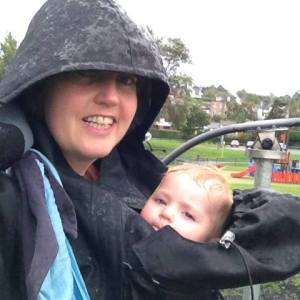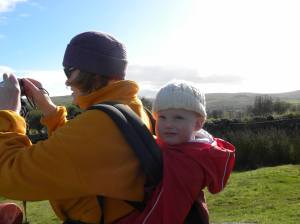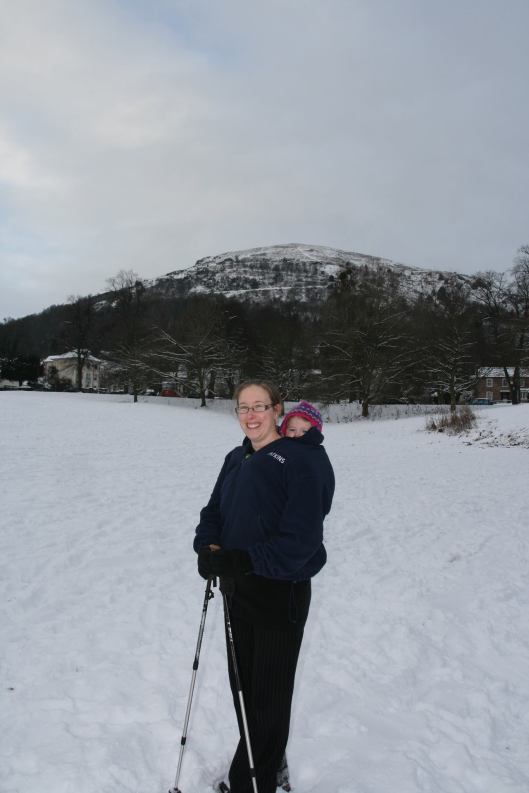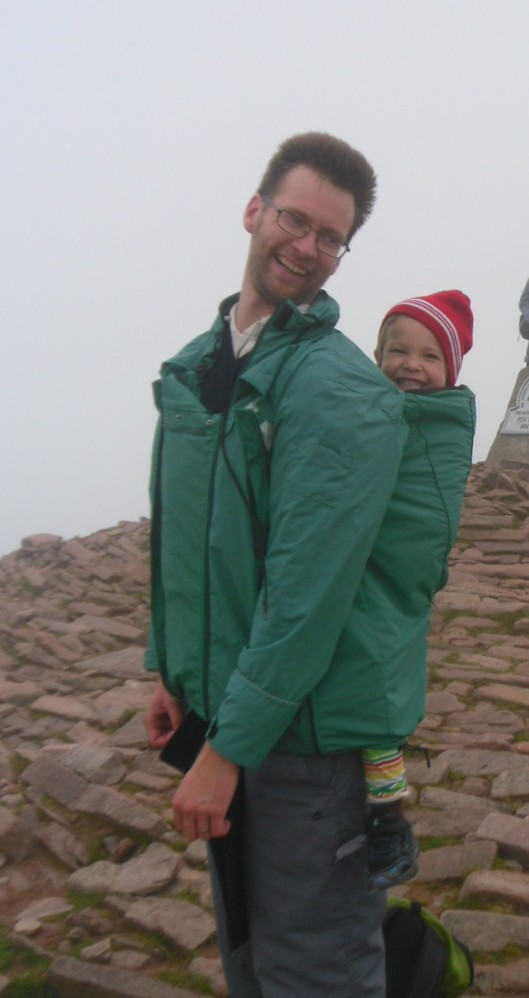So recently we’ve seen some grim weather, with lots of rain reminding us that Summer is over and Autumn is marching on!
While the forecast seems to show nicer weather on the horizon, my thoughts have started to turn to the perennial issue of what you can wear when using slings in inclement weather.
There are various different options, some of which I’ll list below, and all have their advantages and issues. As with slings, what is right for you might not be the same as what is right for your friend or anyone else. Things like your budget, your lifestyle (whether you drive or walk a lot for example, or if you do a lot of hiking in a sling), how much you carry, if you carry on your front or back, and the climate you live in will all impact on your choice.
Using slings over the top of your normal coats
This is one of the simplest and cheapest solutions as it doesn’t require buying anything new, and doesn’t need any additional items to be added to your clothes. It can also be the easiest method if you have an older child who want to come up and down as you don’t have to worry about adjusting clothing, and is often used with older children in back and hip carries.
However it can be more tricky at times, depending on your and your baby’s clothes. A child in a thick padded snowsuit is a very awkward fit into a sling, especially if it makes it harder to adjust their limbs or changes their fit into a more structured carrier. It can also be difficult sometimes if your baby falls asleep whilst wearing thick clothing and you go inside, as then you may have to take them out of the sling and take off their clothing whilst trying to keep them asleep! You also need to be careful to watch thier temperature to check that they don’t overheat, remembering that a layer of sling counts as a layer of clothing, and if you are using a stretchy wrap then that will be three additional layers of clothing. Layers are usually easier to manipulate, and easier to ensure a comfortable temperature. Things like a Bug in a Rug fleece which has flaps that can be unfolded are also a better option than a very thick padded suit.
If it rains then umbrellas can be very handy for some; the large see-through dome umbrellas especially can cover you and your child. However it does mean you need to carry something which may not be suitable for your situation (if you are always pushing a pram, holding hands with a toddler, walking a dog, up on a mountain etc!) and some may find it unwieldy. Slings over waterproof clothing can also be tricky at times as the slippery nature of the fabric competes with the sling!
It is also worth remembering that the more clothes that separate you and your baby, the harder it is for them to share your body heat and regulate their temperature, while you too are less able to adjust layers as needed. A baby who is immobile inside a sling will not be producing their own body heat, whilst you will be moving and getting warm, yet it is hard for either of you can easily adjust your clothing easily to reduce or increase heat.
Using a larger cardigan or coat to wear over the both of you
This is another simple and cheap option that many like to use, especially with smaller babies. You may have a coat (or a wraparound cardigan for the milder autumn days) which is already big enough – anything that you wore during pregnancy can usually fit. Alternatively many people find that their partner’s coats can work too. Larger hoodies and light coats can often be found for fairly cheaply too if you need to get something new without spending very much. If your coat is a bit too small to fit over the two of your snugly, especially as your baby gets bigger, includes putting a coat over the top of your child and their sling to cover the gap where your coat doesn’t meet, by buying a zip in panel such as the Zip Us In, or for crafty folk in the cold but dry weather, you can try knitting or crocheting your own extendable panel like this.

Carrying on the front under an ordinary coat and using a child’s poncho to go over the sling and child.
These undercoat options reduces many of the issues of wrapping over coats; you are sharing body heat by having less layers on, you have less to worry about when you move into different temperatures as you can easily take the coat on and off without disturbing your child, and you don’t have to worry about excess layers making it harder to use your slings.
The main difficulty that you come across is when you look at back carries. While it is pretty simple to do up a coat around the two of you when your baby is on your front, when they are on your back it all becomes more difficult! Some manage it by using a large coat partially zipped so that the baby on your back can have their head out of the top. How well this works depends partly on how big your baby is and how big your coat is – if your baby is quite small it can be hard to ensure that they are out of the coat, if they are too big then it is hard to get them to fit in, while if your coat is not particularly big then you can end up with it riding up too high at your front! Some people find that a generously sized poncho can work well as if the head gap is big enough you can get both and baby through.
Some people find this too awkward or unsuitable for their coats and so carry under their coats for front carries, then carry over the top of their coats when on the back.
Buying a sling cover
For a halfway house between a babywearing coat and your ordinary coats, you could try a babywearing cover. Some of these are specific to particular carriers but can still be used with other slings, others are more universal. For example, the Close Cocoon is designed especially for use with the Close Caboo range of slings but can be used with others, while the MaM babywearing covers are more general and will work on front and back.
These can be less expensive than many specific babywearing coats and so suit some budgets better. Some may also work with strollers and so have uses outside of slings, especially useful if you often switch between slings and pushchairs. As they go round the sling they shouldn’t interfere with getting them in and out of the sling, and allow separate adjustment of you and your baby’s temperature. They are usually waterproof too so will keep your baby dry. However they may not be as good a fit with different slings so their practicality may depend on what you prefer to use. While they are cheaper than a babywearing coat, they may not be that much cheaper than some of the other coats, and of course they can only be used with a sling, while many babywearing coats can be used both with and without slings and so have a longer lifespan.
Making your own babywearing coat
If you decide that you would like your own babywearing coat but your budget doesn’t extend to buying one, then you might think of making your own. This can be as simple or tricky as you’d like it to be, suitable for front carrying and/or back carrying as well. One of the most simple ways involves using fleece. As fleece doesn’t fray, if you want to make something quick and easy you can make something like this DIY babywearing fleece poncho as a cheap way of keeping warm especially in Autumn or milder winters. For more fitted options for the more crafty and sewing machine adept, there are a variety of inspirations, instructions and tutorials available online for both front and back carries, including these ones here from Ocah, Toile Giraffe Blog, and Mama the Geek blog.
These can be a great way to make a cheap alternative that will keep you and baby warm, avoiding the issues of wrapping over clothes often while fitting more comfortably and snugly than a simply larger coat can do. They do require some amount of crafty skill so that may rule out some, but others can play around to their hearts content and find just the right design to suit them and their needs. They do tend to work best with fleece and other similar materials, and so making a waterproof DIY coat can be more tricky, and expensive. If you live somewhere where you are often at the mercy of the rain, and are not happy to have an umbrella then you again would have to consider using slings over clothes or funding a more expensive coat. As ever, how important this is to you will vary on your lifestyle.
Buying a babywearing coat
In some ways this can be one of the easiest options as you can get something that has been specifically designed for carrying your children in a variety of weathers.
Many UK sling retailers sell various babywearing coats so you can find them at the usual sling shops (contact us if you would like details of reliable retailers), and they are also sometimes sold secondhand on the various online forums and facebook group sling selling groups. Babywearing coats can vary from simple gilets coats, hoodies and ponchos, which tend to be at the cheaper end of the spectrum, to more elaborate full coats with waterproof and fleece layers and multiple inserts to adapt for back, hip carrying, pregnancy and tandem carrying. Most are suitable for use without the baby too. They vary in style, from those which are more practical looking to those which are more ‘stylish’. Some brands who make babywearing coats include Boba, Lenny Lamb, Momawo, MaM, Mamalila, Mamaway, Vertbaudet and Suses Kindercoat. These vary in price and use as some are only suitable for front carries.
These can be ideal for many people who carry a lot in all weathers, as they keep warmth next to both baby and you, they don’t interfere with the sling being used and can be taken off when going inside or if the weather changes. They have longetivity as they can be used in different positions, for different ages and for different circumstances (pregnancy, without baby, tandem wearing).
However they are the most expensive option and so whether you want to invest in one will depend a lot on how often you carry. how often you walk, what weather you carry on and so on. If they are used a lot then their ‘price per use’ will decrease and if they are used as your main coat then you are also saving on buying another coat for a period of years. Some people find that they get too hot wearing some of the very warm babywearing coats too so it is worth thinking about this too.
There are so many coats on the market it is impossible to give a full review and description of all brands so to an extent it is worth asking on the various sling groups and forums online for people’s experiences or asking if people at a sling meet have one that you could try on.
Always remember that whatever clothing choice you make to pay attention to your child’s temperature and be aware to remove or add clothing if you are moving in and out of shops or out walking for a long time. Layers and removable accessories like hats, baby legs, bootees, mittens and so on are all easier to adjust and maintain a comfortable temperature than thick bulky clothes.
Enjoy the colder months and enjoy your babywearing!
Many thanks to the Gloucestershire parents who let me use their photos.









Pingback: Snowsuits, Scarves, Slings and Safety • Sheffield Sling Surgery